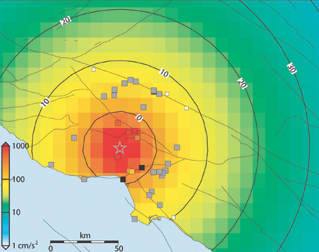Sensing a Vibe: Seismic-alert system could give Los
Angeles a few seconds' warning
Sid Perkins
A sprawling network of seismometers that covers the
Los Angeles area could be adapted to provide warning of
damaging ground motions from earthquakes in the seconds
before those seismic vibes arrive, according to a new
analysis.
 |
|
WHOLE LOTTA SHAKIN'. A warning
system could predict ground motions from an
ongoing quake. This map depicts predicted peak
ground accelerations (color scale) in Southern
California as if estimated 10 seconds after the
1994 Northridge quake began. Numbers in white
boxes indicate warning time in seconds until
arrival of peak ground motion.
Allen |
Some other quake-prone regions already have
early-warning systems. For example, seismic instruments
about 300 kilometers southwest of Mexico City detect the
vibrations spreading from large temblors that occur even
farther to the southwest. That gives residents in the
metropolitan area about 70 seconds' warning.
Could an alert system work in cities, such as Los
Angeles, that rest right on top of active fault zones?
Most parts of even those at-risk areas could receive a
few seconds' warning, says Richard M. Allen, a
seismologist at the University of Wisconsin–Madison.
Earthquakes create several different types of seismic
vibrations. The waves that travel most quickly through
Earth's crust—the so-called P waves—are similar to sound
waves, and they push and pull the ground in the
direction of the waves' trajectory. These waves don't
typically cause damage to buildings or other structures
because of their high frequency and small magnitude,
says Allen. However, these vanguard vibrations contain
information that scientists can use to predict the size
of the more dangerous S waves that follow. Those
shudders, which shake the ground from side to side at
low frequencies, travel at about half the speed of the P
waves.
Allen and his colleague Hiroo Kanamori of the
California Institute of Technology in Pasadena studied
the ground motions for the 53 earthquakes with Richter
scale magnitudes above 5.0 that have occurred in the Los
Angeles area since 1995. The pair found that they could
reasonably predict the magnitude of an earthquake's
yet-to-arrive S waves by looking at the first second of
P waves detected by a seismometer. The best estimates
needed only 4 seconds' seismic data, Allen and Kanamori
report in the May 2 Science.
A warning system that pulled data from the existing
network of seismometers around Los Angeles and performed
similar analyses in real time could provide at least
some residents with a few moments' warning—possibly by
way of sirens or the Internet—of the shaking to come.
For example, at locations 60 km from a temblor's
epicenter, the magnitude of an impending quake could be
known about 16 seconds ahead of time.
That may not sound like much time, but it could avert
some catastrophes, says Allen. Utility companies might
be able to turn off pipelines, manufacturers could shut
down the flow of toxic chemicals, and trains could be
automatically slowed or stopped before the most damaging
ground motions occurred. Also, rescue workers digging
through unstable rubble in the wake of a major quake
could be warned of aftershocks that are on their way.
One particularly valuable application might be to
minimize casualties by having school children dive under
their desks, says John R. Filson, manager of the U.S.
Geological Survey's earthquake hazards program in
Reston, Va.
****************
If you have a comment on this
article that you would like considered for publication
in Science News, send it to editors@sciencenews.org.
Please include your name and location.
To subscribe to Science News (print), go to
https://www.kable.com/pub/scnw/
subServices.asp.
To sign up for the free weekly e-LETTER from
Science News, go to http://www.sciencenews.org/subscribe_form.asp.

References:
Allen, R.M., and H. Kanamori. The
potential for earthquake early warning in Southern
California. Science 300(May 2):786-789. Abstract
available at http://www.sciencemag.org/cgi/content/abstract/300/5620/786.
Further Readings:
Monastersky, R. 1998. Racing the
waves. Science News 153(March 14):169-170.
Available at http://www.sciencenews.org/sn_arc98/3_14_98/bob1.htm.
Sources:
Richard M. Allen
Department of
Geology and Geophysics
University of Wisconsin,
Madison
Madison, WI 53706
John R. Filson
U.S. Geological
Survey
Earthquake Hazards Program
12201 Sunrise
Valley Drive
Reston, VA 20192
|